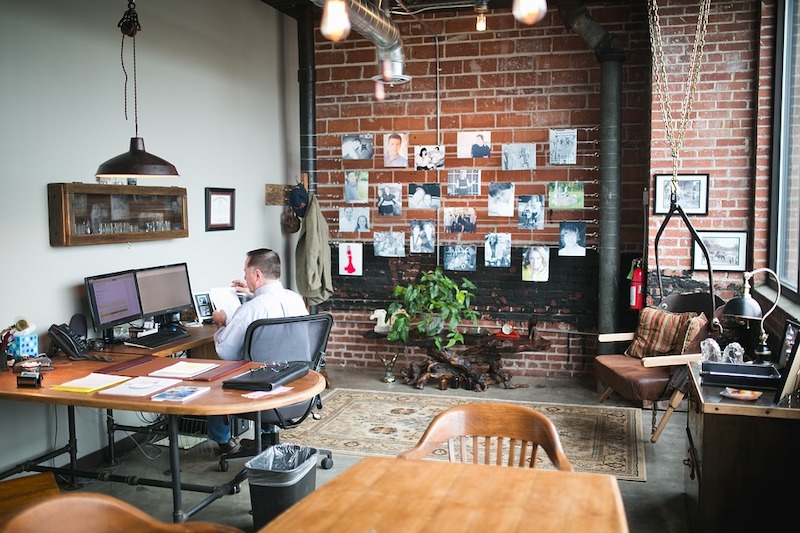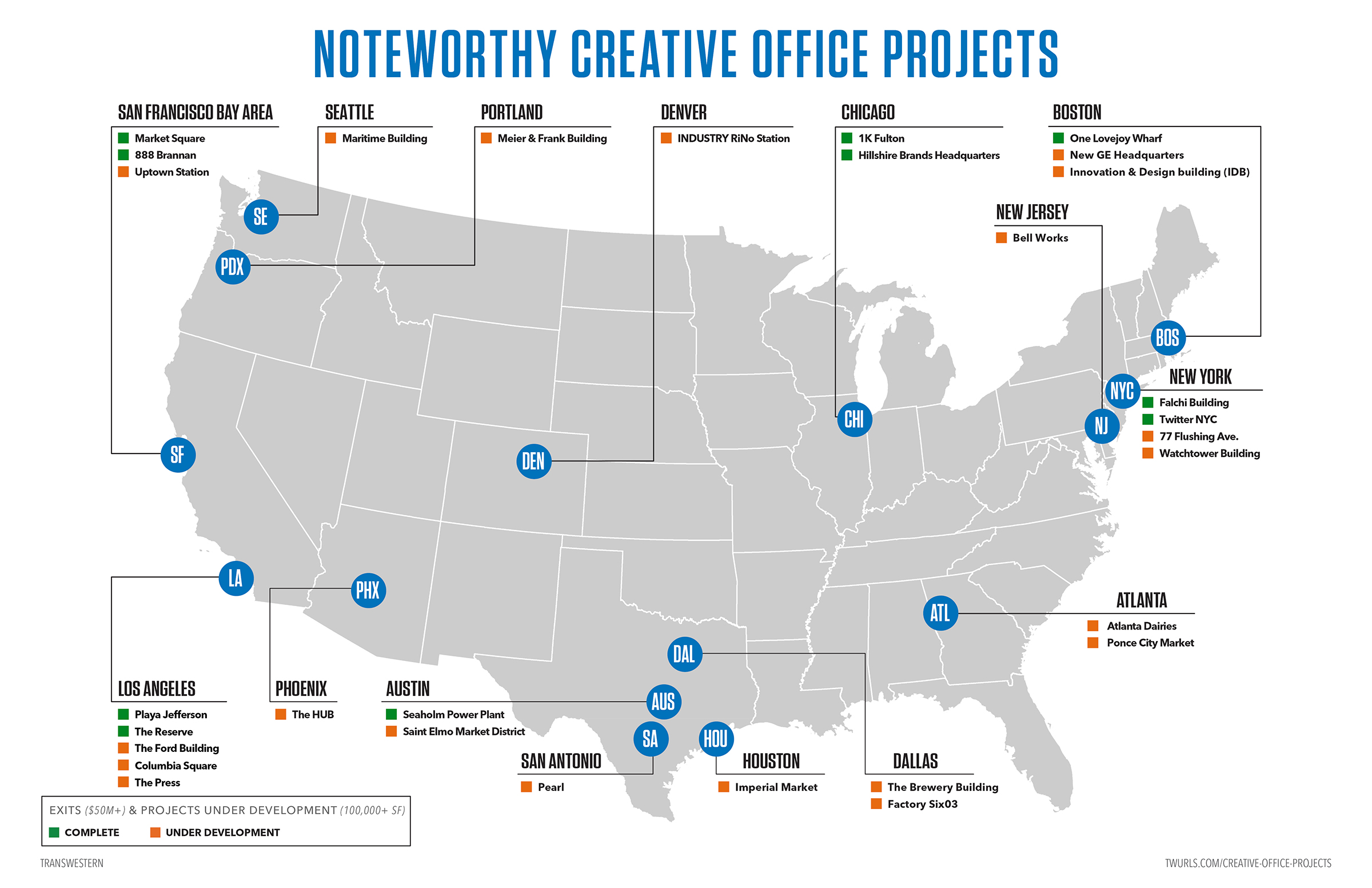Transwestern has released a report examining a number of creative office projects that have generated substantial returns for investors upon completion. The adaptive reuse developments span Boston, Chicago, Los Angeles, New York, Phoenix, San Francisco, and Austin, Texas. The report also highlights 20 additional large creative office projects currently underway across the country.
Michael Soto, Director of Research in Southern California and co-author of the report, explains that while creative office conversions are not new, what is different this cycle is the sheer volume of creative office exits nationally at core/core-plus pricing that have occurred during the past five years – with the buyers being major institutional investors or well-known owner/users.
“The conversion of a property from industrial or retail use to creative office has become an increasingly popular value-add strategy for investors,” Soto says in a release. “Two trends are fueling demand for this type of differentiated office product: One, technology, advertising, media and other companies trying to attract millennials are interested in the characteristic features of creative office space – open floor plans, natural lighting, common spaces and amenities such as cafés and rec rooms. And two, tenants are returning to cities, where they can take advantage of live/work/play environments.”
Based on favorable exit pricing of some major creative office projects around the country, this type of value-add strategy, on this large scale, is now being considered by developers, either via direct investment or joint-venture partnerships with equity partners. Conversely, stabilized creative office properties are on the radar of many national and international institutional buyers that are paying traditional trophy Class A pricing for these types of properties, usually based on the credit-worthiness of the tenant, as well as the location of the project.
The report cautions, however, that many of these projects were acquired and developed under very different economic conditions than exist today.
“Rising land, building and construction costs – especially in hot neighborhoods – may add more risk when compared to a few years ago, when we were at a different point in the real estate cycle,” said Sandy McDonald, Director of Research in Chicago and co-author of the report. “In addition, adaptive reuse often comes with hidden costs and potentially expensive future property modifications.”
Moreover, the popularity of the creative office concept means that there is more inventory in the market today. Landlords that own existing office buildings or are doing ground-up development are realizing that they must consider strategic property enhancements and creative office-associated tenant amenities to stay competitive in the marketplace.
To view the complete report, titled Creative Office Projects: Adaptive Reuse Generates Staggering Returns for Investors, click here.
Related Stories
| Feb 11, 2011
RS Means Cost Comparison Chart: Office Buildings
This month's RS Means Cost Comparison Chart focuses on office building construction.
| Feb 11, 2011
Kentucky’s first green adaptive reuse project earns Platinum
(FER) studio, Inglewood, Calif., converted a 115-year-old former dry goods store in Louisville, Ky., into a 10,175-sf mixed-use commercial building earned LEED Platinum and holds the distinction of being the state’s first adaptive reuse project to earn any LEED rating. The facility, located in the East Market District, houses a gallery, event space, offices, conference space, and a restaurant. Sustainable elements that helped the building reach its top LEED rating include xeriscaping, a green roof, rainwater collection and reuse, 12 geothermal wells, 81 solar panels, a 1,100-gallon ice storage system (off-grid energy efficiency is 68%) and the reuse and recycling of construction materials. Local firm Peters Construction served as GC.
| Feb 11, 2011
Chicago architecture firm planning one of China’s tallest towers
Chicago-based Goettsch Partners was commissioned by developer Guangzhou R&F Properties Co. Ltd. to design a new 294,570-sm mixed-use tower in Tianjin, China. The Tianjin R&F Guangdong Tower will be located within the city’s newly planned business district, and at 439 meters it will be one of China’s tallest buildings. The massive complex will feature 134,900 sm of Class A office space, a 400-key, five-star hotel, 55 condominiums, and 8,550 sm of retail space. The architects are designing the tower with multi-story atriums and a high-performance curtain wall to bring daylight deep into the building, thereby creating deeper lease spans. The project is currently finishing design.
| Jan 21, 2011
Manufacturing plant transformed into LEED Platinum Clif Bar headquarters
Clif Bar & Co.’s new 115,000-sf headquarters in Emeryville, Calif., is one of the first buildings in the state to meet the 2008 California Building Energy Efficiency Standards. The structure has the largest smart solar array in North America, which will provide nearly all of its electrical energy needs.
| Jan 19, 2011
Baltimore mixed-use development combines working, living, and shopping
The Shoppes at McHenry Row, a $117 million mixed-use complex developed by 28 Walker Associates for downtown Baltimore, will include 65,000 sf of office space, 250 apartments, and two parking garages. The 48,000 sf of main street retail space currently is 65% occupied, with space for small shops and a restaurant remaining.
| Jan 7, 2011
Mixed-Use on Steroids
Mixed-use development has been one of the few bright spots in real estate in the last few years. Successful mixed-use projects are almost always located in dense urban or suburban areas, usually close to public transportation. It’s a sign of the times that the residential component tends to be rental rather than for-sale.
| Jan 4, 2011
An official bargain, White House loses $79 million in property value
One of the most famous office buildings in the world—and the official the residence of the President of the United States—is now worth only $251.6 million. At the top of the housing boom, the 132-room complex was valued at $331.5 million (still sounds like a bargain), according to Zillow, the online real estate marketplace. That reflects a decline in property value of about 24%.
| Jan 4, 2011
Grubb & Ellis predicts commercial real estate recovery
Grubb & Ellis Company, a leading real estate services and investment firm, released its 2011 Real Estate Forecast, which foresees the start of a slow recovery in the leasing market for all property types in the coming year.
| Dec 17, 2010
Vietnam business center will combine office and residential space
The 300,000-sm VietinBank Business Center in Hanoi, Vietnam, designed by Foster + Partners, will have two commercial towers: the first, a 68-story, 362-meter office tower for the international headquarters of VietinBank; the second, a five-star hotel, spa, and serviced apartments. A seven-story podium with conference facilities, retail space, restaurants, and rooftop garden will connect the two towers. Eco-friendly features include using recycled heat from the center’s power plant to provide hot water, and installing water features and plants to improve indoor air quality. Turner Construction Co. is the general contractor.















